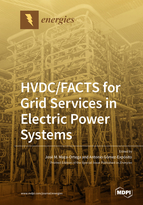HVDC/FACTS for Grid Services in Electric Power Systems
A special issue of Energies (ISSN 1996-1073). This special issue belongs to the section "F: Electrical Engineering".
Deadline for manuscript submissions: closed (1 September 2019) | Viewed by 49987
Special Issue Editors
Interests: management of electric energy; efficient management of electric energy; electrical machines; electric energy systems; quality and efficiency of power supply; AC/DC devices and systems
Interests: circuit theory; electrical power systems; transient and dynamic analysis of electrical systems; operation and control of electrical systems; electric power systems II; AC/DC devices and systems; numerical methods for electrical systems
Special Issue Information
Dear Colleagues,
Electric power systems are headed for a true changing of the guard due to the urgent need for decarbonized and sustainable energy delivery. Fortunately, the development of new technologies is driving the transition of power systems towards a carbon-free paradigm, while at the same time maintaining current standards of quality, efficiency and resiliency. The introduction of HVDC and FACTS in the 20th century, taking advantage of dramatic improvements in power electronics and control, gave rise to unprecedented levels of flexibility and speed of response in comparison with traditional electromechanical devices. This flexibility is nowadays more required than ever in order to solve a puzzle with pieces that do not always fit perfectly.
This Special Issue aims to address the role that FACTS and HVDC systems can play in helping electric power systems face the challenges of the near future. The contributions should preferably focus on the grid services that these technologies may bring, rather than on advances in individual devices. The topics of interest include, but are not limited to:
- HVDC/FACTS providing services for transmission systems in combination with renewable plants and/or storage systems: frequency control, var/voltage regulation, backup reserve, energy imbalance, inertia provision, congestion release, load following, black-start capability, remote automatic generation control, network loss reduction, emergency control action, etc.
- MVDC/D-FACTS providing services for distribution systems in combination with distributed generation and storage: voltage control, reactive power support, supply restoration, power quality maintenance, congestion management, balancing and reconfiguration, integration of renewable energies, etc.
- Application of innovative devices or concepts based on HVDC/FACTS technologies for providing grid services: advanced secondary substations involving custom power devices, hybrid AC/DC transmission and distribution systems, advanced charging stations for electric vehicles, etc.
- Advanced control systems for HVDC/FACTS providing grid services: centralized and distributed approaches, coordinated controllers with minimal communication infrastructure, robust controllers, etc.
Prof. Dr. José M. Maza-Ortega
Prof. Dr. Antonio Gómez-Expósito
Guest Editor
Manuscript Submission Information
Manuscripts should be submitted online at www.mdpi.com by registering and logging in to this website. Once you are registered, click here to go to the submission form. Manuscripts can be submitted until the deadline. All submissions that pass pre-check are peer-reviewed. Accepted papers will be published continuously in the journal (as soon as accepted) and will be listed together on the special issue website. Research articles, review articles as well as short communications are invited. For planned papers, a title and short abstract (about 100 words) can be sent to the Editorial Office for announcement on this website.
Submitted manuscripts should not have been published previously, nor be under consideration for publication elsewhere (except conference proceedings papers). All manuscripts are thoroughly refereed through a single-blind peer-review process. A guide for authors and other relevant information for submission of manuscripts is available on the Instructions for Authors page. Energies is an international peer-reviewed open access semimonthly journal published by MDPI.
Please visit the Instructions for Authors page before submitting a manuscript. The Article Processing Charge (APC) for publication in this open access journal is 2600 CHF (Swiss Francs). Submitted papers should be well formatted and use good English. Authors may use MDPI's English editing service prior to publication or during author revisions.
Keywords
- HVDC
- FACTS
- Ancillary services
- Decarbonized power systems






